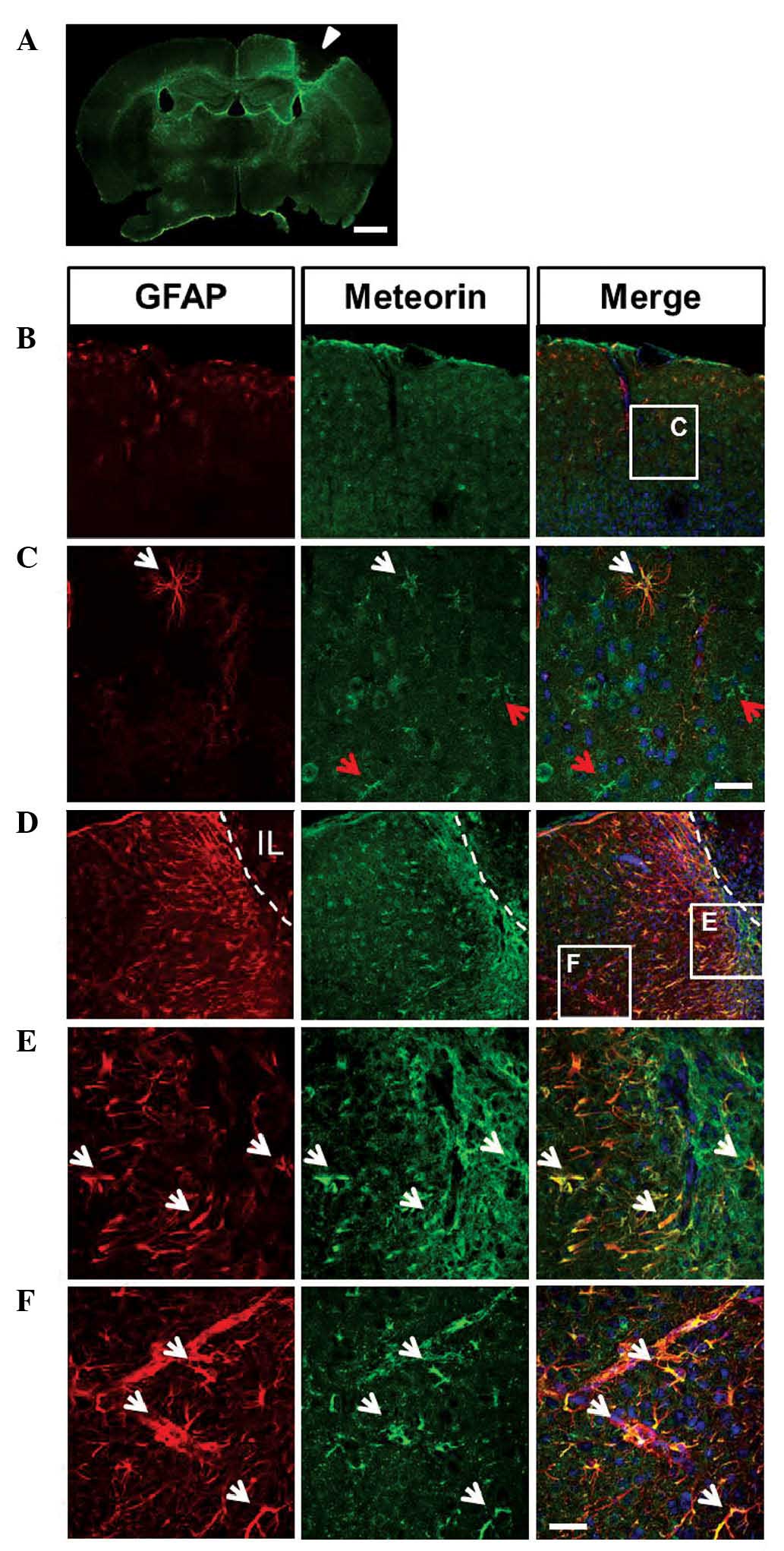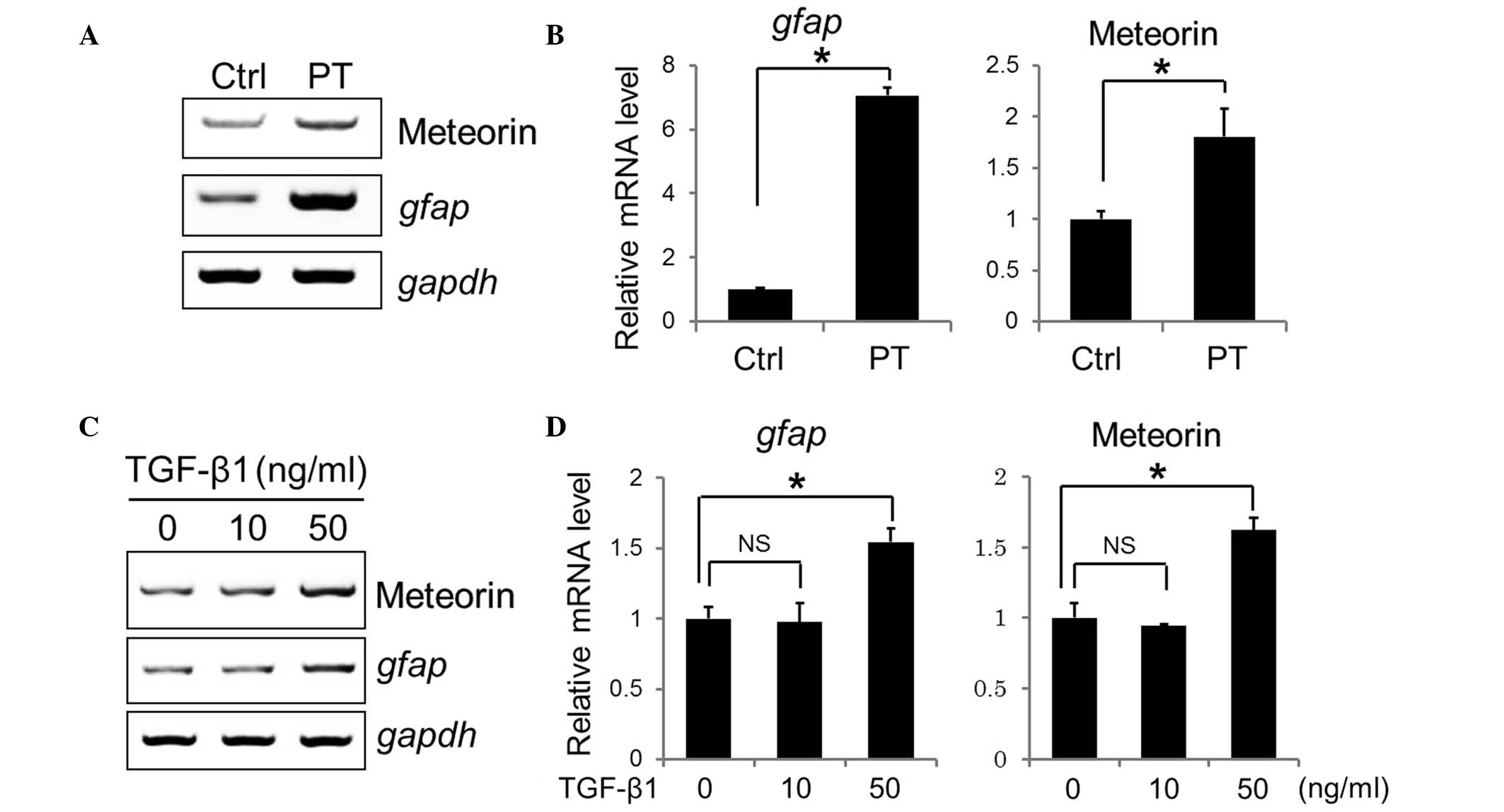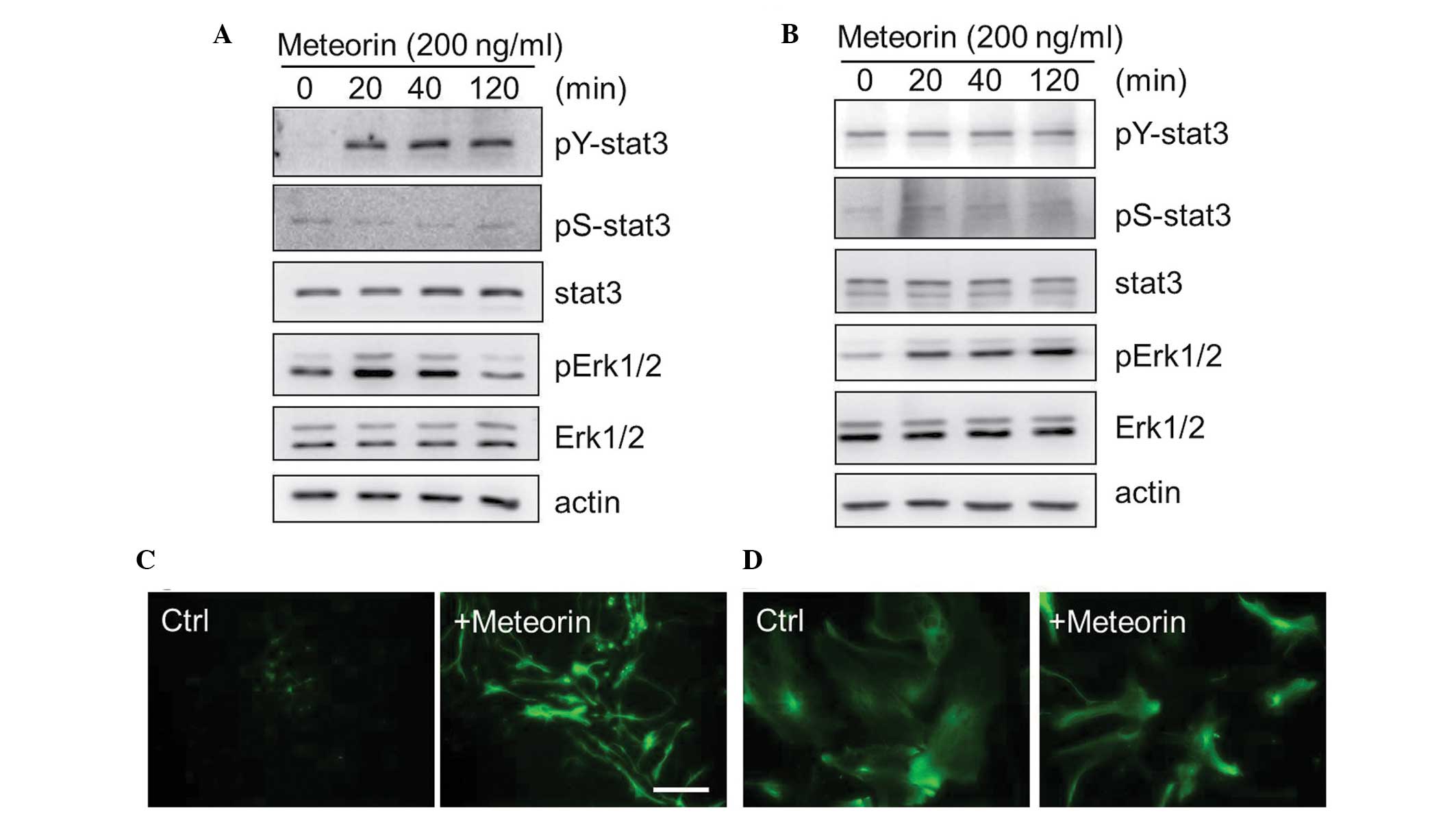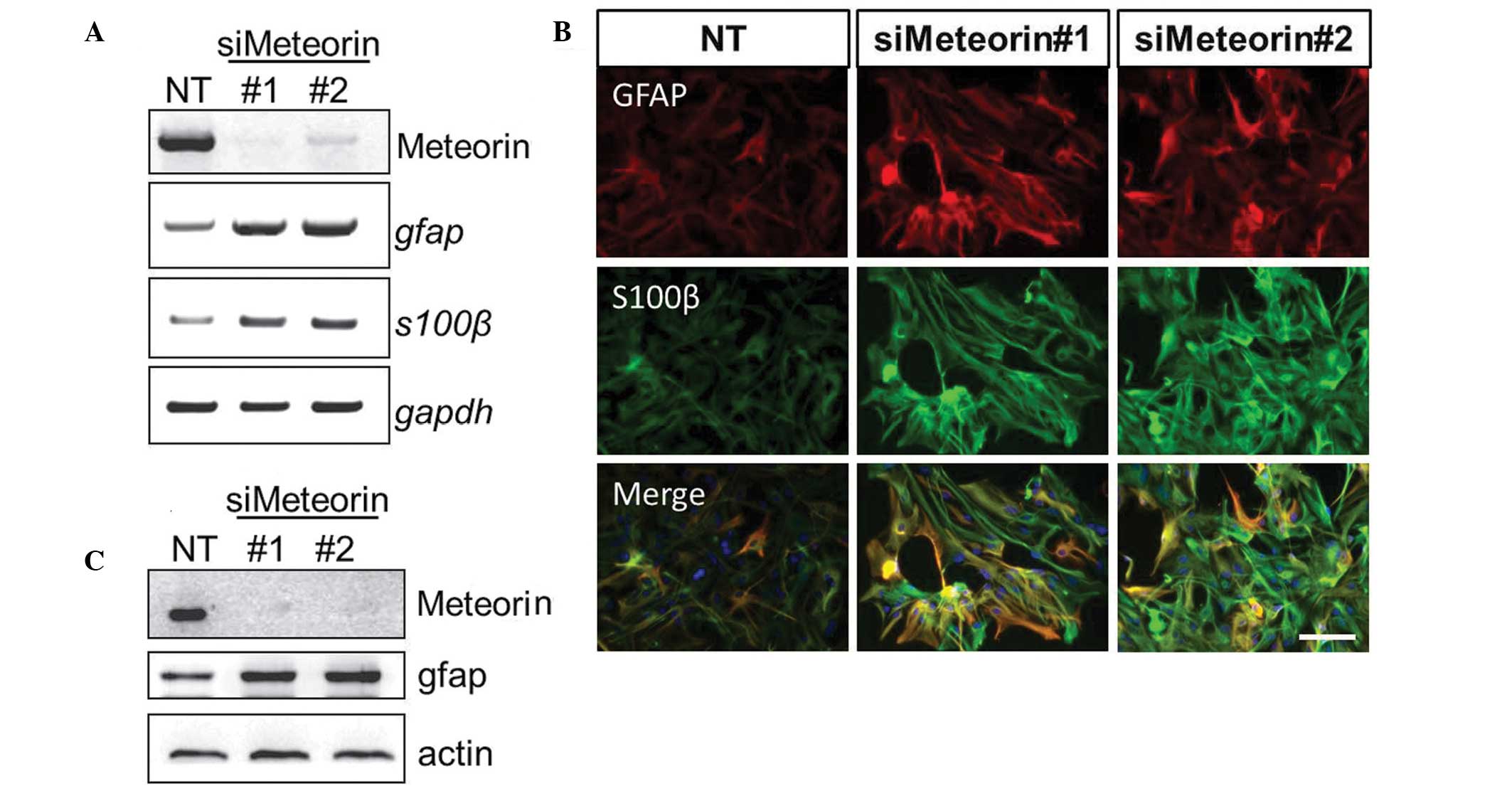Meteorin is upregulated in reactive astrocytes and functions as a negative feedback effector in reactive gliosis
- Authors:
- Published online on: April 14, 2015 https://doi.org/10.3892/mmr.2015.3610
- Pages: 1817-1823
-
Copyright: © Lee et al. This is an open access article distributed under the terms of Creative Commons Attribution License [CC BY_NC 3.0].
Abstract
Introduction
Astrocytes are a type of macroglial cell, and are the most abundant type of cell in the central nervous system (CNS) (1). Astrocytes were previously considered to have predominantly supportive roles to assist in appropriate neuronal functions; however, with the development of molecular neuroscience, studies have revealed several active roles of astrocytes, including the regulation of blood flow (2,3), involvement in synaptic functions (1,4) and maintenance of the blood-brain barrier (BBB) integrity (5).
Reactive gliosis is an astrocytic response to a wide range of CNS pathologies, which results in morphological and molecular changes in the resting glia. Although the extent of the changes in astrocytes due to astrogliosis vary with the nature and severity of an insult, there are certain changes that astrocytes commonly undergo in response to all forms of CNS insult, including hypertrophy, proliferation and the upregulation of molecules, including glial fibrillary acidic protein (GFAP) and S100β (6). In certain severe case of CNS injury, a physical barrier, referred to as a ‘glial scar’ is formed by glial cells undergoing reactive gliosis, to isolate the damaged tissue from the healthy region and to prevent a cascade of inflammation, caused by factors released from the lesion site (7). However, it is difficult to categorize the effect of the glial scar as beneficial or harmful in terms of clinical outcome, since this tight physical barrier also inhibits the regeneration of damaged neurons at a later stage of injury (8–10). Therefore, determining the mechanisms by which reactive gliosis is regulated may improve clinical outcomes, however, the molecular and cellular mechanisms underlying the initiation, progression and resolution of this process remain to be fully elucidated.
Meteorin is a secreted protein, which was initially screened as a retinoic-acid-responding molecule (11). In the developing rodent CNS, meteorin is highly expressed in the neuroepithelium and remains in subpopulations of the glia, including the cortical astrocytes, following completion of CNS development (11,12). Our previous study reported that meteorin promotes glial differentiation in neural stem cells (NSCs) via activation of the janus kinase (Jak)-signal transducer and activator of trascription 3 (STAT3) signaling pathway (12), and that astrocytic meteorin promotes the maturation of the BBB by stimulating endothelial cells (13). Regarding its involvement in CNS pathologies, previous studies have reported on the neuroprotective effects of meteorin in rat models of neuropathic pain and in quinolic acid-induced neuropathology (14,15). In addition, a previous study identified a novel function of meteorin in promoting neuroblast migration in a stroke model (16). Despite emerging evidence regarding the crucial functions of meteorin in neuropathologies, its role in the glial response to CNS insults remains to be elucidated.
The predominant source of meteorin in the adult brain are astrocytes, and meteorin is known to promote glial cell differentiation and the expression of GFAP in NSCs (12,17); therefore, the present study aimed to demonstrate that meteorin was involved in the reactive gliosis process. The expression levels of meteorin were analyzed in reactive astrocytes from a photothrombotic (PT) ischemia mouse model, as well as following stimulation of transforming growth factor (TGF)-β, which led to the activation of astrocytes in vitro. A small interfering RNA (siRNA)-mediated meteorin-knockdown was performed to identify the role of meteorin in reactive gliosis.
Materials and methods
Induction of PT ischemia in vivo
C57BL/6 mice (3–6 months old) were purchased from Samtako (Daejeon, Korea) and PT ischemia was induced, as described previously (18). Briefly, under deep anesthesia by intraperitoneal injection of Zoletil® (30 mg/kg) and Rompun® (10 mg/kg) (Virbac, Carros, France), rose bengal photosensitive dye (Sigma-Aldrich; 0.1 ml of a 10% solution/25 g body weight) was injected into the tail vein and allowed to circulate for 5 min. The skull was then exposed to a cold light source (150 W, 1 mm diameter; Zeiss FL1500 LCD; Carl Zeiss AG) for 20 min, 2.5 mm to the left and 2.5 mm to the back of the bregma. A total of 7 days following PT induction, the mice were deeply anesthesized and cardiac tissue was perfused with PBS, followed by 4% paraformaldehyde/PBS solution for immunohistochemical analysis. Alternatively, fresh brain tissue was isolated, without cardiac perfusion, and the lesion sites were dissected to isolate total RNA. Contralateral hemisphere tissue was considered as a control.
The animal experiments of the present study were approved by the Committee for Care and Use of Laboratory Animals at the Seoul National University (Seoul, Korea), according to the Guide for Animal Experiments edited by the Korean Academy for Medical Sciences. The mice were maintained in a specific pathogen-free room in the animal-housing facilities at Seoul National University under a 12-h dark/light cycle with a provision of chow and water ad libitum.
Cell culture and purification of recombinant meteorin
Primary cultures of mouse cortical astrocytes were prepared from the brains of 2 day-old mice (Samtako). The mice were sacrificed by decapitation, and the brains were isolated. The cerebral cortices were dissected from the mouse brains and the meninges were removed. The cortices were then diced into 1–2 mm sections and incubated in 0.25% trypsin (Life Technologies, Carlsbad, CA, USA) and 20 mg/ml DNase I (Sigma-Aldrich, St. Louis, MO, USA) at 37°C for 20 min. The sections were then dissociated into single cells by pipetting. The cells were plated and cultured in Dulbecco’s modified Eagle’s medium (DMEM; Life Technologies), supplemented with 10% fetal bovine serum (FBS; Life Technologies) and 1% penicillin/streptomycin (Life Technologies). After 7–10 days of culture, the cells were agitated at 250 rpm for 16 h, in order to remove the microglia and oligodendrocytes. Once the cells had reached 80% confluence they were treated with the indicated amount of TGF-β1 (10 or 50 ng/ml; PeproTech, Rocky Hill, NJ, USA) for 24 h.
Primary NSCs were cultured from E13.5 mouse embryos, as described previously (12). Briefly, embryos were dissected from pregnant female mice (Samtako) and neurospheres were allowed to form in complete neurobasal medium (Invitrogen Life Technologies) containing 2% B27 (Invitrogen Life Technologies), human epidermal growth factor (20 ng/ml, R&D Systems, Minneapolis, MN, USA), and basic fibroblast growth factor (10 ng/ml, Invitrogen Life Technologies) for 4 days, by plating neuroepithelial cells on non-coated culture dishes. For in vitro differentiation, the neurospheres were dissociated with trypsin-EDTA and plated onto poly-L-ornithine (Sigma-Aldrich)-coated dishes in complete medium. The neurospheres were treated with 200 ng/ml recombinant meteorin for 48 h following an overnight deprivation of growth factors.
Recombinant mouse meteorin was purified from the conditioned medium of CHO-K1 Chinese hamster ovary cells (Korean Cell Line Bank, Seoul, Korea) stably expressing meteorin tagged with myc-His6 at C-terminus, as described previously (13). CHO-K1 cells were maintained in DMEM supplemented with 10% FBS at 37°C in a humidified atmosphere containing 5% CO2.
siRNA preparation and transfection
The following siRNAs were synthesized and were used to target mouse meteorin: siMeteorin #1, 5′-GTTCAGCCGTGTCTATTCA-3′; and siMeteorin #2, 5′-GTCTTCGCTGAACGTATGA-3′. Non-targeting siRNAs were used as a control (GE Dharmacon, Lafayette, CO, USA). The astrocytes were transfected with the siRNAs using oligofectamine (Invitrogen Life Technologies, Carlsbad, CA, USA) once they had reached ~50% confluence.
Western blot analysis and reverse transcription-quantitative polymerase chain reaction (RT-qPCR)
The astrocytes were lysed using 1X cell lysis buffer (Cell Signaling Technology Inc., Beverly, MA, USA). Protein concentration was determined using bicinchoninic acid protein assay kit (Invitrogen Life Technologies). The protein samples (40 μg) were then separated by 12% SDS-PAGE and transferred to nitrocellulose membranes (GE Healthcare Life Sciences, Piscataway, NJ, USA). After blocking with 5% skim milk/phosphate-buffered saline (PBS) with 0.1% Tween-20, the membranes were immunoblotted with the following antibodies overnight at 4°C: Rabbit anti-phospho-STAT3 (Tyr705) (1:2,000 cat. no. 9131; Cell Signaling Technology, Inc.), rabbit anti-STAT3 (1:5,000; cat. no. sc-482; Santa Cruz Biotechnology, Inc., Dallas, TX, USA), rabbit anti-GFAP (1:1,000; cat. no. s0334; DAKO, Glostrup, Denmark) and rabbit anti-actin (1:10,000; cat. no. A2668; Sigma-Aldrich). The membranes were then probed with anti-rabbit secondary antibodies conjugated to horseradish peroxidase (1:5,000; cat. no. HAF008; R&D Systems) for 1 h at room temperature, and proteins were visualized using an enhanced chemiluminescence system (Intron Biotechnology, Gyeonggi-do, Korea). Band intensities were quantified using MultiGauge v.3.0 software (Fujifilm, Tokyo, Japan).
RT-qPCR was performed, as described previously (12). Briefly, total RNA was isolated using TRIzol® reagent (Invitrogen Life Technologies), according to the manufacturer’s instructions. To isolate total RNA from brain tissue, the samples were homogenized in TRIzol by passing through a 30 gauge needle of a 1 ml syringe. First-stranded cDNA was synthesized from 2 μg total RNA using a murine leukemia virus reverse transcriptase (Promega Corporation, Madison, WI, USA). A total of 2 μl cDNA was then amplified by PCR using the following thermocycling conditions: 95°C for 30 sec, 55°C for 30 sec, 72°C for 60 sec, 25 cycles on a thermal cycler (Applied Biosystems, Foster City, CA, USA). The PCR products were visualized following separation by 1.5% agarose gel electrophoresis and the band intensities were quantified using MultiGauge v.3.0 software (Fujifilm). The following primers (Bioneer Corporation, Daejeon, Korea) were used to amplify each gene: Meteorin, forward 5′-ATGCTGGTAGCCACGCTTCTTT-3′ and reverse 5′-GTCCAGTGCCATCTCACATGGG-3′), Gfap, forward 5′-GGCCGGGGCGCTCAA-3′ and reverse 5′-GCCGACTCCCGCGCAT-3′), S100β, forward 5′-GGTTGCCCTCATTGATGTCT-3′, and reverse 5′-GTCCAGCGTCTCCATCACTT-3′ and Gapdh, forward 5′-ACCACAGTCCATGCCATCAC-3′ and reverse 5′-TCCACCACCCTGTTGCTGTA-3′).
Immunohistochemistry
Coronal brain sections (30 μm thickness) isolated from mice 7 days following PT induction were prepared using a cryotome and collected in PBS. Free-floating sections were then permeabilized with PBS-0.25% Triton-X, blocked with 5% FBS, and treated with the following primary antibodies: Rabbit anti-GFAP (1:750; DAKO), goat anti-meteorin (1:100; R&D Systems, Minneapolis, MN, USA), and mouse anti-S100β (1:500; Sigma-Aldrich) in 5% FBS overnight at 4°C. Following extensive washing with PBS-0.25% Triton-X, the sections were incubated with Alexa Fluor-conjugated secondary antibodies (1:100) for 2 h at room temperature, and the tissues were mounted using FluorSave™ Reagent (EMD Millipore, Billerica, MA, USA). Images of the tissues were captured using an M200 ApoTome microscope (Carl Zeiss AG, Oberkochen, Germany) and a LSM700 confocal microscope (Carl Zeiss AG).
Statistical analysis
The data are expressed as the mean ± standard error of the mean. Statistical significance was determined using an unpaired two-tailed Student’s t-test in Microsoft Excel 2010 (Microsoft Corporation, Redmond, WA, USA). P<0.05 was considered to indicate a statistically significant difference.
Results
Meteorin is upregulated in reactive astrocytes following PT insult
To determine the functions of meteorin in reactive gliosis, the present study examined its expression in reactive astrocytes using immunofluorescent staining. The PT ischemia mouse model was used as a brain injury model, in which photochemical occlusion of the irradiated vessels with secondary tissue ischemia is induced by photosensitive dyes like rose-bengal and a local irradiation of cold light through the skull (19). At 7 days following PT induction, infarct lesions were observed and a glial scar surrounding the lesions had formed, as revealed by GFAP staining (Fig. 1A). In the cortex of the contralateral hemisphere, in which the majority of astrocytes are at a resting state, only a subset of astrocytes, predominantly beneath the meningeal epithelium or surrounding blood vessels exhibited GFAP immunoreactivity. Double immunostaining of GFAP and meteorin demonstrated that, not only GFAP-positive, but also GFAP-negative astrocytes exhibited weak expression levels of meteorin (Fig. 1B and C). This pattern of meteorin staining in the normal brain was concordant with the findings of our previous study and of others (11,13,17).
By contrast, a marked increase in the number of GFAP-positive cells was observed in the cortex exhibiting infarct lesions, and these cells exhibited significantly more marked GFAP staining (Fig. 1A and D–F). Furthermore, a typical glial scar formed at the edge of the infarct lesion, where the GFAP-positive cells had built a dense network. The meteorin staining pattern in the infarct side was similar to that of GFAP, being more marked in the glial scar region and exhibiting a gradual decrease in the areas distant from the infarct lesion (Fig. 1D–F). To further confirm the upregulation of meteorin induced by PT, the cortex of the infracted hemisphere and the contralateral hemisphere were dissected, and total RNAs were extracted to compare the mRNA expression levels of meteorin and Gfap. RT-qPCR revealed a 1.7-fold increase in the expression of meteorin and a 7-fold increase in Gfap (Fig. 2A and B). These data indicated that the expression of meteorin was increased in the reactive astrocytes, activated by PT insult.
Expression of meteorin is increased in response to TGF-β stimulation in vitro
The activation of astrocytes can be triggered by various factors, including cytokines and nitric oxide, which are produced by microglia and other immune cells in infarct lesions (7). To determine whether the in vitro stimulation of astrocyte activation leads to changes in the expression of meteorin, primary mouse cortex astrocytes were cultured and treated with increasing doses of TGF-β1, which is a well-known reactive gliosis-promoting factor (20). Treatment with recombinant TGF-β1 at a concentration of 50 ng/ml resulted in ~1.5-fold and 1.7-fold increases in the mRNA expression levels of Gfap and meteorin, respectively. However, no effects were observed following treatment of the cells with 10 ng/ml TGF-β1 (Fig. 2C and D).
Meteorin activates different signaling pathways in astrocytes and NSCs
Our previous study demonstrated that the Jak-STAT3 pathway is a downstream signaling unit of meteorin in neural progenitor cell differentiation (12). Therefore, the present study aimed to analyze the effects of recombinant meteorin treatment on astrocyte activation in comparison to its effects on NSCs. Concordant with the findings of our previous report, treatment of the NSCs, from embryonic mouse brain tissues cultured with recombinant meteorin (200 ng/ml) induced the tyrosine phosphorylation of STAT3 and activation of extracellular signal-regulated kinase (Erk)1/2, as early as 20 min after treatment (Fig. 3A). The phosphorylation of STAT3 by meteorin was not detected in the astrocytes, although subsequent Erk1/2 activation was observed (Fig. 3B). The NSCs and astrocytes were also treated with recombinant meteorin for 3 days, followed by GFAP staining, to determine whether meteorin treatment increased the expression of GFAP. Treatment of NSCs with meteorin resulted in an increase in the number of GFAP-positive cells, possibly due to hyperactivation of STAT3 signaling (Fig. 3C). However, no significant changes in GFAP staining were observed in the astrocyte cultures treated with the same dose of meteorin (Fig. 3D). These results indicated that meteorin activated different signaling pathways depending on the cell type, but appears unlikely to act as an inducer of reactive gliosis.
Silencing the expression of meteorin results in upregulation of reactive astrocyte markers
To further analyze the role of meteorin in astrocyte activation, the gene expression of meteorin was silenced using siRNAs specifically targeting mouse meteorin. Efficient knockdown of the expression of metorin in astrocytes using two different siRNAs was confirmed by RT-qPCR and western blotting. A correlation between the expression of meteorin and astrocyte activation was determined by comparing the expression levels of GFAP and S100β. The two meteorin-targeting siRNAs resulted in increased mRNA and protein expression levels of GFAP and S100β, determined by RT-qPCR and western blotting, respectively (Fig. 4A and C). In addition, immunocytochemical staining for GFAP and S100β was more marked in the astrocytes transfected with meteorin-targeting siRNAs (Fig. 4B). These results suggested the possible function of meteorin in a negative feedback loop in reactive gliosis, during which glial activation is resolved and cells revert to their resting state.
Discussion
The present study analyzed the expression profile and functions of meteorin in reactive gliosis in the mouse brain. The results demonstrated: i) Meteorin was expressed in cortical astrocytes and its expression was upregulated in reactive astrocytes; ii) exogenous application of meteorin to astrocytes did not activate STAT3 signaling; and iii) silencing the expression of meteorin in astrocytes led to the upregulation of reactive astrocyte markers.
In the majority of CNS injuries, astrocytes undergo reactive gliosis, which can be beneficial and detrimental. Although a physical barrier, by formation of a glial scar, is the primary defense against damage, the beneficial effects of reactive gliosis are also mediated by the secretion of soluble factors (20). For example, the expression of ciliary neurotrophic factor is known to be increased in reactive astrocytes following ischemic insult, and its neuroprotective effects have been demonstrated in a wide range of animal models of CNS injury (21–23).
It is noteworthy that meteorin has been reported to have neuroprotective effects in various neuropathologiacal models (14,15). A possible scenario, based on previous studies (14,15,20) and the present study, is that cytokines, including TGF-β1, trigger reactive gliosis to promote the production of meteorin by astrocytes, and meteorin subsequently acts on neurons to regenerate axons in a paracrine manner. In addition, meteorin may signal to astrocytes in an autocrine manner as a negative feedback factor, which in turn leads to the resolution of reactive gliosis. Notably, one of the beneficial effects of reactive gliosis is to restore the BBB following brain injury (24,25), and our previous study identified meteorin as a maturation factor for brain vascular development (13). Therefore, analyzing the effects of meteorin administration in vivo following brain injury, in terms of neuroprotection, reactive gliosis and BBB integrity is worthwile.
Since the first report regarding meteorin in 2004 (11), numerous lines of investigation by independent groups have uncovered its novel functions and characteristics (11–16). However, the cellular receptor(s) of meteorin remain to be elucidated. In our previous study, the Jak-STAT3 pathway was found to be involved in the downstream signaling of meteorin in NSC differentiation. In the present study, meteorin did not activate the same pathway in astrocytes, indicating another layer of complexity in meteorin signaling. One possible explanation is that there is more than one meteorin receptor, which is differentially expressed in distinct cell types and they activate distinct signaling pathways; however, additional investigations are required to confirm this hypothesis.
Acknowledgments
The present study was supported by the Global Research Laboratory Program (grant no. 2011-0021874), the Global Core Research Center Program (grant no. 2011-0030001), the National Research Foundation grant, funded by the Ministry of Science, ICT, and Future Planning ((grant no. 2013-036038)) and the Basic Science Research Program through the NRF of Korea, funded by the Ministry of Education (grant no. 2013R1A1A2058956).
References
|
Volterra A and Meldolesi J: Astrocytes, from brain glue to communication elements: The revolution continues. Nat Rev Neurosci. 6:626–640. 2005. View Article : Google Scholar : PubMed/NCBI | |
|
Iadecola C and Nedergaard M: Glial regulation of the cerebral microvasculature. Nat Neurosci. 10:1369–1376. 2007. View Article : Google Scholar : PubMed/NCBI | |
|
Hamby ME and Sofroniew MV: Reactive astrocytes as therapeutic targets for CNS disorders. Neurotherapeutics. 7:494–506. 2010. View Article : Google Scholar : PubMed/NCBI | |
|
Seifert G, Schilling K and Steinhäuser C: Astrocyte dysfunction in neurological disorders: A molecular perspective. Nat Rev Neurosci. 7:194–206. 2006. View Article : Google Scholar : PubMed/NCBI | |
|
Abbott NJ, Rönnbäck L and Hansson E: Astrocyte-endothelial interactions at the blood-brain barrier. Nat Rev Neurosci. 7:41–53. 2006. View Article : Google Scholar | |
|
Sofroniew MV: Reactive astrocytes in neural repair and protection. Neuroscientist. 11:400–407. 2005. View Article : Google Scholar : PubMed/NCBI | |
|
Sofroniew MV: Molecular dissection of reactive astrogliosis and glial scar formation. Trends Neurosci. 32:638–647. 2009. View Article : Google Scholar : PubMed/NCBI | |
|
Silver J and Miller JH: Regeneration beyond the glial scar. Nat Rev Neurosci. 5:146–156. 2004. View Article : Google Scholar : PubMed/NCBI | |
|
Di Giorgio FP, Carrasco MA, Siao MC, Maniatis T and Eggan K: Non-cell autonomous effect of glia on motor neurons in an embryonic stem cell-based ALS model. Nat Neurosci. 10:608–614. 2007. View Article : Google Scholar : PubMed/NCBI | |
|
Nagai M, Re DB, Nagata T, et al: Astrocytes expressing ALS-linked mutated SOD1 release factors selectively toxic to motor neurons. Nat Neurosci. 10:615–622. 2007. View Article : Google Scholar : PubMed/NCBI | |
|
Nishino J, Yamashita K, Hashiguchi H, Fujii H, Shimazaki T and Hamada H: Meteorin: A secreted protein that regulates glial cell differentiation and promotes axonal extension. EMBO J. 23:1998–2008. 2004. View Article : Google Scholar : PubMed/NCBI | |
|
Lee HS, Han J, Lee SH, Park JA and Kim KW: Meteorin promotes the formation of GFAP-positive glia via activation of the Jak-STAT3 pathway. J Cell Sci. 123:1959–1968. 2010. View Article : Google Scholar : PubMed/NCBI | |
|
Park JA, Lee HS, Ko KJ, et al: Meteorin regulates angiogenesis at the gliovascular interface. Glia. 56:247–258. 2008. View Article : Google Scholar | |
|
Tornøe J, Torp M, Jørgensen JR, et al: Encapsulated cell-based biodelivery of meteorin is neuroprotective in the quinolinic acid rat model of neurodegenerative disease. Restor Neurol Neurosci. 30:225–236. 2012.PubMed/NCBI | |
|
Jørgensen JR, Xu XJ, Arnold HM, et al: Meteorin reverses hypersensitivity in rat models of neuropathic pain. Exp Neurol. 237:260–266. 2012. View Article : Google Scholar : PubMed/NCBI | |
|
Wang Z, Andrade N, Torp M, et al: Meteorin is a chemokinetic factor in neuroblast migration and promotes stroke-induced striatal neurogenesis. J Cereb Blood Flow Metab. 32:387–398. 2012. View Article : Google Scholar : | |
|
Jørgensen JR, Thompson L, Fjord-Larsen L, et al: Characterization of Meteorin-an evolutionary conserved neurotrophic factor. J Mol Neurosci. 39:104–116. 2009. View Article : Google Scholar | |
|
Cha JH, Wee HJ, Seo JH, et al: AKAP12 mediates barrier functions of fibrotic scars during CNS repair. PLoS One. 9:e946952014. View Article : Google Scholar : PubMed/NCBI | |
|
Watson BD, Dietrich WD, Busto R, Wachtel MS and Ginsberg MD: Induction of reproducible brain infarction by photochemically initiated thrombosis. Ann Neurol. 17:497–504. 1985. View Article : Google Scholar : PubMed/NCBI | |
|
John GR, Lee SC and Brosnan CF: Cytokines: Powerful regulators of glial cell activation. Neuroscientist. 9:10–22. 2003. View Article : Google Scholar : PubMed/NCBI | |
|
Beurrier C, Faideau M, Bennouar KE, et al: Ciliary neurotrophic factor protects striatal neurons against excitotoxicity by enhancing glial glutamate uptake. PLoS One. 5:e85502010. View Article : Google Scholar : PubMed/NCBI | |
|
Fang M, He D, Zhang F, et al: Antineuroinflammatory and neurotrophic effects of CNTF and C16 peptide in an acute experimental autoimmune encephalomyelitis rat model. Front Neuroanat. 7:442013. View Article : Google Scholar | |
|
Rhee KD, Nusinowitz S, Chao K, Yu F, Bok D and Yang XJ: CNTF-mediated protection of photoreceptors requires initial activation of the cytokine receptor gp130 in Müller glial cells. Proc Natl Acad Sci USA. 110:E4520–E4529. 2013. View Article : Google Scholar | |
|
Bush TG, Puvanachandra N, Horner CH, et al: Leukocyte infiltration, neuronal degeneration and neurite outgrowth after ablation of scar-forming, reactive astrocytes in adult transgenic mice. Neuron. 23:297–308. 1999. View Article : Google Scholar : PubMed/NCBI | |
|
Faulkner JR, Herrmann JE, Woo MJ, Tansey KE, Doan NB and Sofroniew MV: Reactive astrocytes protect tissue and preserve function after spinal cord injury. J Neurosci. 24:2143–2155. 2004. View Article : Google Scholar : PubMed/NCBI |













